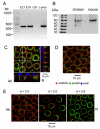A prestin motor in chicken auditory hair cells: active force generation in a nonmammalian species
- PMID: 23746629
- PMCID: PMC3713163
- DOI: 10.1016/j.neuron.2013.05.018
A prestin motor in chicken auditory hair cells: active force generation in a nonmammalian species
Abstract
Active force generation by outer hair cells (OHCs) underlies amplification and frequency tuning in the mammalian cochlea but whether such a process exists in nonmammals is unclear. Here, we demonstrate that hair cells of the chicken auditory papilla possess an electromechanical force generator in addition to active hair bundle motion due to mechanotransducer channel gating. The properties of the force generator, its voltage dependence and susceptibility to salicylate, as well as an associated chloride-sensitive nonlinear capacitance, suggest involvement of the chicken homolog of prestin, the OHC motor protein. The presence of chicken prestin in the hair cell lateral membrane was confirmed by immunolabeling studies. The hair bundle and prestin motors together create sufficient force to produce fast lateral displacements of the tectorial membrane. Our results imply that the first use of prestin as a motor protein occurred early in amniote evolution and was not a mammalian invention as is usually supposed.
Copyright © 2013 Elsevier Inc. All rights reserved.
Figures








Similar articles
-
Depolarization of cochlear outer hair cells evokes active hair bundle motion by two mechanisms.J Neurosci. 2006 Mar 8;26(10):2757-66. doi: 10.1523/JNEUROSCI.3808-05.2006. J Neurosci. 2006. PMID: 16525055 Free PMC article.
-
Expression of prestin, a membrane motor protein, in the mammalian auditory and vestibular periphery.Hear Res. 2003 Oct;184(1-2):27-40. doi: 10.1016/s0378-5955(03)00192-8. Hear Res. 2003. PMID: 14553901
-
Activity-dependent regulation of prestin expression in mouse outer hair cells.J Neurophysiol. 2015 Jun 1;113(10):3531-42. doi: 10.1152/jn.00869.2014. Epub 2015 Mar 25. J Neurophysiol. 2015. PMID: 25810486 Free PMC article.
-
Active hair bundle movements in auditory hair cells.J Physiol. 2006 Oct 1;576(Pt 1):29-36. doi: 10.1113/jphysiol.2006.115949. Epub 2006 Aug 3. J Physiol. 2006. PMID: 16887874 Free PMC article. Review.
-
Cochlear amplification, outer hair cells and prestin.Curr Opin Neurobiol. 2008 Aug;18(4):370-6. doi: 10.1016/j.conb.2008.08.016. Epub 2008 Oct 4. Curr Opin Neurobiol. 2008. PMID: 18809494 Free PMC article. Review.
Cited by
-
Regeneration in the Auditory Organ in Cuban and African Dwarf Crocodiles (Crocodylus rhombifer and Osteolaemus tetraspis) Can We Learn From the Crocodile How to Restore Our Hearing?Front Cell Dev Biol. 2022 Jul 4;10:934571. doi: 10.3389/fcell.2022.934571. eCollection 2022. Front Cell Dev Biol. 2022. PMID: 35859896 Free PMC article.
-
SLC26 Anion Transporters.Handb Exp Pharmacol. 2024;283:319-360. doi: 10.1007/164_2023_698. Handb Exp Pharmacol. 2024. PMID: 37947907 Review.
-
Expression and Misexpression of the miR-183 Family in the Developing Hearing Organ of the Chicken.PLoS One. 2015 Jul 15;10(7):e0132796. doi: 10.1371/journal.pone.0132796. eCollection 2015. PLoS One. 2015. PMID: 26176784 Free PMC article.
-
Hair Cell Transduction, Tuning, and Synaptic Transmission in the Mammalian Cochlea.Compr Physiol. 2017 Sep 12;7(4):1197-1227. doi: 10.1002/cphy.c160049. Compr Physiol. 2017. PMID: 28915323 Free PMC article. Review.
-
AAV-ie-K558R mediated cochlear gene therapy and hair cell regeneration.Signal Transduct Target Ther. 2022 Apr 22;7(1):109. doi: 10.1038/s41392-022-00938-8. Signal Transduct Target Ther. 2022. PMID: 35449181 Free PMC article.
References
Publication types
MeSH terms
Substances
Grants and funding
LinkOut - more resources
Full Text Sources
Other Literature Sources

